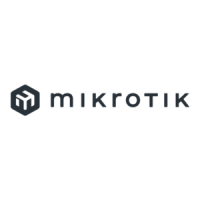RouterBOARD 500 Series User's Manual
On high-voltage jumper position, in order to power the board with voltage lower than approximately 30V
DC, you may need to close the JP7 PoE control jumper, located near the S1 button. Note that only the
RB532c build version accepts 25..56V DC powering.
To power the board from -48V telecom power lines (or any other negative voltage within the supported
range), connect GND power wire to the positive contact of the J14, and -48V wire to the negative contact.
Positive contact is the nearest to the power jack square (◘) contact on the power header.
RouterBOARD 500 series boards are compliant with IEEE802.3af Power over Ethernet standard and accept
48V powering over up to 100m (330 ft) long Ethernet cable connected to the first Ethernet port (J6 or J12).
JP5 and JP6 jumpers choose whether to accept power form PoE-enabled Ethernet port (position 2-3) or from
the power jack/header (position 1-2). The board also accepts 12V DC (or any other within the 11..22V
range) non-standard PoE input voltage (see note above on how to use it).
Booting options
First, RouterBOOT loader is started. It displays some useful information on the onboard RS232C
asynchronous serial port, which is set to 115200bit/s, 8 data bits, 1 stop bit, no parity, hardware (RTS/CTS)
flow control by default. The loader may be configured to boot the system from the onboard NAND module,
an internal storage device, or from Ethernet network. See the respective section of this manual for how to
configure booting sequence and other boot loader parameters.
Onboard NAND Storage Device
The RouterBOARD may be started from the onboard NAND storage chip. As there is no partition table on the
device, the boot loader assumes the first 4MiB form a YAFFS filesystem, and executes the file called “kernel”
stored in the root directory on that partition. It is possible to partition the rest of the medium by patching
the kernel source.
Internal Storage Device
The RouterBOARD may be started from a CompactFlash module or a Microdrive hard drive. At least two
partitions must exist on the device, first of which being the ELF image the board is to be booted from
(normally, it is a Linux kernel, appended with the kernparm ELF section that specifies the root partition
name and, optionally, other kernel parameters of your choice).
Booting from network
Network boot works similarly to PXE or EtherBoot protocol, and allows you to boot the RouterBOARD 500
series computer from an executable image stored on a TFTP server. It uses BOOTP or DHCP (configurable in
boot loader) protocol to get a valid IP address, and TFTP protocol to download an executable (ELF) kernel
image combined with the initial RAM disk (inserted as an ELF section) to boot from (the server's IP address
and the image name must be sent by the BOOTP/DHCP server).
To boot the RouterBOARD computer from Ethernet network you need the following:
● An ELF kernel image for the loader to boot from (you can embed the kernel parameters and initrd
image as ELF sections called kernparm and initrd respectively)
● A TFTP server which to download the image from
● A BOOTP/DHCP server (may be installed on the same machine as the TFTP server) to give an IP
address, TFTP server address and boot image name
See the RouterBOOT section on how to configure loader to boot from network.
Note that you must connect the RouterBOARD you want to boot, and the BOOTP/DHCP and TFTP servers to
the same broadcast domain (i.e., there must not be any routers between them).
Operating System Support
System Architecture
RouterBOARD 500 series embedded boards are fully compatible with the standard MIPS32 architecture with
PCI bus.
CPU. RouterBOARD 500 series has MIPS32 little-endian based embedded processor using MIPS 4Kc CPU
core. It is fully binary-compatible with all software developed for MIPS32 little-endian (mipsel) instruction
set architecture. The MIPS 4Kc core includes TLB Memory Management Unit and does not include Float Point
Unit (so it is optimized for integer operations).
8

